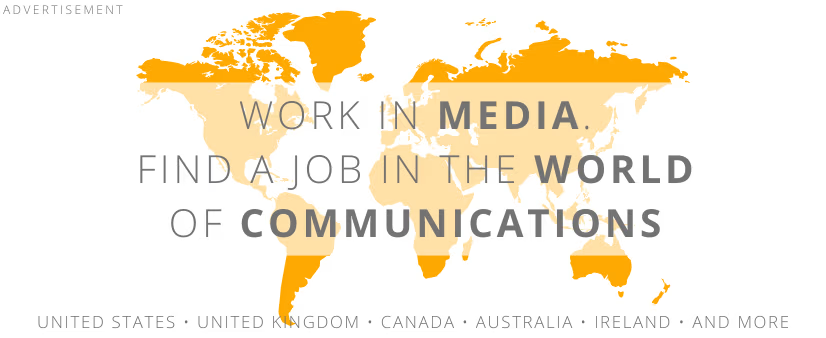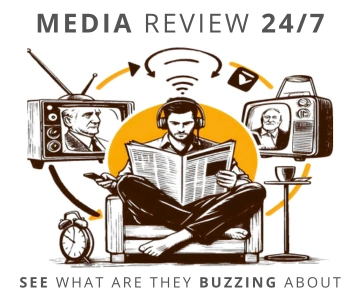The word, written in a document every American child knows by heart: or rather, in the First Amendment to that document: "Congress shall make no law respecting an establishment of religion, or prohibiting the free exercise thereof; or abridging the freedom of speech, or of the press; or the right of the people peaceably to assemble, and to petition the Government for a redress of grievances."
When the Constitution was adopted in 1787, it did not yet contain these crucial 45 words upon which the entire modern media phenomenon in America rests. The First Amendment came into effect on December 15, 1791, but how to reconcile freedom of speech with burning flags, violent heavy metal lyrics, tobacco ads, pornography, and many other phenomena is a topic for a future installment in this series. Today, we look back at the roots of the "fourth estate" and briefly recall its history.
American media have come a long way since the first colonial newspaper, "Publick Occurrences: Both Foreign and Domestick," was published on September 25, 1690, in Boston. It lasted only one day before British authorities shut it down. However, by the 1730s, the American press was strong enough to criticize British rule without fear of repercussions. The first commercial radio stations, launched in the early 20th century, ended the monopoly of print media, allowing the entire society to participate in the thrilling spectacle of "live" media. When television, the medium with the greatest impact on audiences, entered the scene shortly after World War II, America enjoyed an ever-increasing diversity of media, with fierce competition among them. Satellite technology, cable networks, and interactive media became new trends governing the media world at the turn of the last century.
Both print and electronic media are inseparable companions of Americans’ daily lives. According to recent studies, over 98% of Americans own a television, with 82% tuning in during prime time. 84% of Americans listen to the radio regularly, 79% read newspapers, and 45% of the population has internet access and uses it for informational purposes.
Economic factors play a significant role in shaping the information reaching the average "everyday person" in the USA. While non-profit organizations have a meaningful voice in media discussions, the vast majority of public information sources, such as major city newspapers, weekend magazines, television networks, and cable channels, are profit-driven.
The U.S. media generate a total income of around $242 billion and rank among the largest business groups in America. In recent years, the average American adult has spent about $675 annually on information and entertainment. Adding in advertising revenue (around $215 billion) explains how this impressive machine operates, employing hundreds of thousands of technicians, writers, artists, journalists, and intellectuals who shape human attitudes and beliefs.
In the United States, the right to information is one of the pillars of social life. The power held by the media is evident from cases like the Watergate scandal. In the 1970s, journalists uncovered and exposed a scandal that ultimately led to President Richard Nixon’s resignation. Many reports of corruption end with the arrest of reporters and closure of newspapers, but not in the USA, where shutting down editorial offices for political reasons is unthinkable.
In 1990, the American press celebrated its 300th anniversary. Today, across the United States, there are approximately 1,490 daily newspapers and 917 weekly newspapers, with a combined daily circulation estimated at - an astonishing! - 115 million copies. The most popular include:
- "The Wall Street Journal" (1,762,751),
- "USA Today" (1,692,666),
- "The New York Times" (1,097,180),
- "Los Angeles Times" (1,033,399)
- "The Washington Post" (762,009).
Each of these newspapers, thanks to new technologies, systematically expands its reach. "USA Today," produced and published in McLean, Virginia, is transmitted via satellite for printing to 32 locations across the United States and two facilities serving Europe and Asia. The "International Herald Tribune," closely linked to "The New York Times" and "The Washington Post," is now a global newspaper, published in 11 world capitals and distributed in 164 countries.
Most American print publications have online counterparts, as do radio stations, of which there are about 10,700 across the United States. Notably, only a few of these stations belong to public broadcasting, which is limited to universities and other public institutions funded by government grants and listener donations.
Television holds the largest audience and thus the greatest influence on shaping public opinion. The three main private television networks - NBC, CBS, and ABC - supported solely by advertising, control 90% of the market. Among cable networks, themed programs have gained popularity, with Cable News Network, the news channel created by Ted Turner, and MTV, broadcasting music videos 24 hours a day, leading the way.
In short, Americans have plenty of choices. Hundreds of TV channels, thousands of newspapers, and tens of thousands of radio stations offer the chance to build an objective image of Uncle Sam. Despite a very stable market situation and detailed legal regulations, American media still have much to debate. Currently, discussions focus on protecting the privacy of public figures. Caught by intrusive cameras, senators file lawsuits against stations that, under the First Amendment, inform the public of the darker sides of their representatives. On the other hand, many reporters collaborate with politicians to hide the system`s flaws from the public. So, are the media the "fourth estate," or are they simply trying to appear as one? We will explore this question further in our series.
Read all articles in the series The Fourth Estate in America.
COMMERCIAL BREAK
New articles in section History of the media
The History of The New York Times. All the news that's fit to print
Małgorzata Dwornik
In the heart of 19th-century New York, when news from across the world traveled via telegraph and the newspaper was the voice of public opinion, two ambitious journalists created a modest four-page daily that would eventually become a legend.
FORTUNE. The story of the most exclusive business magazine
Małgorzata Dwornik
Half of the pages in the pilot issue were left blank. Only one printing house in the country could meet the magazine’s quality standards. They coined the terms "business sociology" and "hedge fund". They created the world’s most prestigious company ranking. This is the story of Fortune.
History of Le Soir. A Belgian daily once free for ground floor readers
Małgorzata Dwornik
It started with an unusual sales policy and articles written personally by the king. This is where the comic hero Tintin made his name. The "fake edition" from the II World War went down in history. "Le Soir" more than once found itself targeted by authorities, censors, and even... terrorists and hackers.
See articles on a similar topic:
The History of Television
BARD
In 1875, Ernest von Siemens constructed the first photocell. Two years later, Julian Ochorowicz, a Polish psychologist, developed the theoretical foundations of monochromatic television. In 1924, Scotsman John Baird transmitted an image over a distance. In Poland, we waited until 1952 for the first broadcast.
Die Burger. The history of the world’s largest afrikaans newspaper
Małgorzata Dwornik
Founded in 1915 by Afrikaners from the Union of South Africa, this newspaper embodies colonial history in a nutshell. On one hand, it supported independence and a local language; on the other, it actively endorsed apartheid until its end. Polish connections and renowned internet brands from our country are also part of this story.
History of television in Australia. It all began with a studio in a windmill
Małgorzata Dwornik
Already in 1885, thanks to Telephane, an invention by Henry Sutton, it was possible to watch horse races for the Melbourne Cup. The first real television broadcasts, conducted from 1934 at the old windmill on Wickham Terrace in Brisbane, were watched by only 18 television owners, but by the following year, test transmissions had begun in other major cities.
Christiane Amanpour. A Fighter for Freedom of Speech at CNN
Małgorzata Dwornik
Her reports from war fronts and social documentaries brought her recognition. Her uncompromising interviews with the most influential figures in global politics earned her fame and respect. Christiane Amanpour is a living legend of the media and an advocate for women's, children's, and minority rights.





























